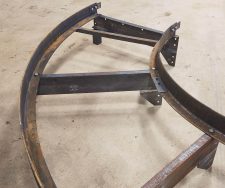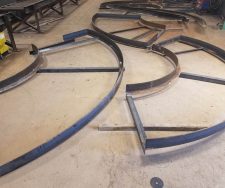SHOP
Your Full-Service Steel Fabricator
Our Capabilities
We aim to fabricate the future, together. Our team leverages innovative technologies, efficient work processes, and experienced local craftspeople to provide you with a wide range of solutions within our state-of-the-art facility, which boasts a fabricating capacity of up to 44” on the beam line. Our steel fabrication capabilities include:
- Steel Structures
- Top Access-Platforms
- Spiral Stairs and Landings
- Agitator Bridges
- Skirts
- Ring Girders
- Circular/Rolled Platforms
- Pipe Racks
- Pipe Supports
- Additional Components: Handrails, Grating, Stairs, Ladders
- Raw Material Forms: Sheet, Tubing, Angles, Flat Stocks, Channels, Beams, Round Bar, and Square Bar.
Gallery
Videos
Steel Fabrication Technology
We utilize state-of-the-art technology for our structural steel fabrication process. As a result, TMI Fabricators is able to create custom industrial steel products that meet the specific needs of our clients.
- SDS/2 Modeling Software: Detailing services using the latest SDS/2 modeling software to assist in fabrication.
- Strumis Purchasing Software: Strumis, a cutting-edge purchasing software system that streamlines the working process, maximizes material efficiency, and increases productivity.
- CNC Cutting and Drilling: CNC technology with a ficep excaliber single spindle drill line and a Messer Edgemax burntable for precision cutting and drilling.
Quality Assurance Process
TMI Fabricators is committed to providing the highest quality steel fabrication products and services. We have a comprehensive quality assurance process that begins with the careful selection of materials. We only produce high-quality steel that meets or exceeds industry standards.
Once the materials have been selected, our team of experienced fabricators will use state-of-the-art equipment to cut, bend, and weld the steel into the desired shape. During the fabrication process, our quality control team will conduct regular inspections to ensure that the steel meets our strict standards. Once the fabrication is complete, we will install the steel according to the specifications provided by the customer.
- American Welding Society certified: All welders are AWS-certified.
- AISC code adherence: Standard tolerances of a 1/8” while adhering to the AISC code of standard practice.
- 100% inspection: One hundred percent inspection with multiple hold points throughout by certified welding inspectors.
- Mill certifications: Mill certifications for every piece of material.
- Inspection record-keeping: Meticulous record-keeping of inspections—from dimension checks to hole layouts and paint DFTS.
Steel Finishing
We have a broad steel finishing capacity range, from applying a simple red oxide primer to various three-part systems. This includes:
- Painting: Our in-house painting area is 100’ x 150’, and we have a NACE level 2 inspector who oversees all painting to ensure the highest quality. We use a three-step process for painting steel. This process produces a high-quality paint job that protects steel from corrosion and wear.
- Pre-treat the steel to ensure optimal paint adhesion
- Apply the primer and paint
- Cure the paint to ensure a long-lasting finish.
- Blasting: Our blasting process happens in our 20’ x 50’ steel shot/grit blasting booth. We offer mechanical and hand blaster options, so you can choose the best method that suits your needs. Our mechanical blasters use high-pressure air to remove paint and other debris from metal surfaces, while our hand blasters are perfect for smaller jobs or areas requiring more precision.
Types of Steel We Fabricate
We fabricate a wide range of steel types, including:
- Carbon Steel: Carbon steel fabrication involves taking a steel alloy and adding carbon to it to increase the hardness and strength of the metal. The steel is then heated to high temperatures and cooled quickly, which helps preserve the metal’s new properties. Carbon steel is often used in construction and manufacturing applications.
- Stainless Steel: Our stainless-steel fabrication begins with creating a “primary alloy.” This is typically done by melting iron and chromium together in a furnace. Next, we add other elements, such as nickel or molybdenum, to create the desired alloy.
- Hardened Steel: To make hardened steel, we create steel with a high carbon content, and once cooled and solidified, we heat treat to increase the hardness further. The steel is heated to a high temperature and then cooled rapidly. This process, known as quenching, creates a harder steel that is less likely to break or deform under stress.
- Abrasion Plate: Steel that is specifically designed to resist wear and tear. It is often used in high-impact areas with a lot of friction, such as chutes, conveyors, and decks.
- Aluminum: Aluminum is one of the most versatile materials available for fabrication. Strong and lightweight, it’s ideal for various applications, easily formed into shapes, and has high corrosion resistance. We draw metal into thin sheets, roll it, and weld it together. The resulting product is then anodized to give it a protective coating.
Steel Forming
Our forming processes include shaping, sharing, rolling, and oxyfuel cutting. These enable us to create various shapes and sizes to meet our customers’ needs. We use state-of-the-art equipment to ensure precision every time.
- Sawing: The saw blade is mounted on a motorized arm and is passed through the steel at high speed. It can be operated manually or by an automatic control system.
- Oxy-Fuel Cutting: The oxy-fuel cutting process uses a torch to heat steel until it reaches its melting point. Oxy-fuel cutting produces little waste, as the molten steel can be collected and reused.
- Plasma Cutting: The plasma torch uses an electrical arc to ionize a gas stream, creating a plasma jet reaching temperatures up to 30,000°F. This high-heat plasma jet is then used to cut through the steel.
Welding Processes
- SMAW
- GTAW
- GMAW
- FCAW
Raw Material Forms
- Sheet
- Tubing
- Angles
- Flat stocks
- Channels
- Beams
- Round bar
- Square bar
Leadership & Craftsmanship
- Welding inspectors (CWI)
- NACE level 2 inspector
- Welders
- Foreman
Quality Assurance & Testing
- Radiographic examination
- Magnetic particle examination
- Liquid penetrant examination
- Ultrasonic examination
- Penetrant testing
Prefabricated Skids
Our skid fabrication can also revolutionize your modular construction projects. Time savings and adherence to codes and standards are crucial in today’s construction industry. We provide innovative solutions incorporating modular process skids, enabling streamlined construction projects and controlled environments meeting industry requirements.
Learn More About Our Steel Fabrication Shop
If you’re interested in learning more about steel fabrication or other services offered by TMI Fabricators, contact us today. We look forward to assisting you with your industrial projects.




















